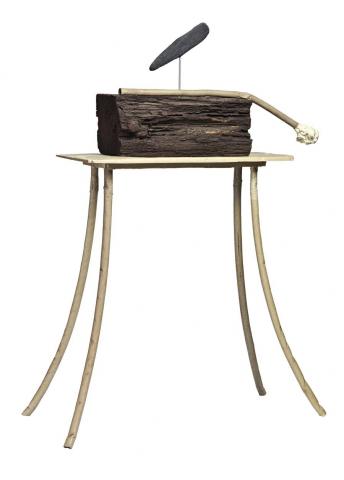SPHINX, 2009
HANY ARMANIOUS
cast pigmented polyurethane resin, cast pewter
150.0 x 107.0 x 47.0 cm
Roslyn Oxley9 Gallery, Sydney
Private collection, Sydney
Uncanny Valley, Roslyn Oxley9 Gallery, Sydney, 26 March 2009
Australia Council for the Arts, Sydney, 4 June - 24 November 2011
With his enduring interest in the readymade and figurative traditions of sculpture, as well as the real and illusory potential of art, Hany Armanious is internationally renowned as the author of mysterious, beguiling works that seek to confound and provoke through their exploration of the energy embedded within inanimate objects. Embracing forms, processes and materials from a myriad of traditions - ancient, non-Western idolatry to cosmology, magic and mysticism, and twentieth-century modernism as espoused by figures including Duchamp, Brancusi and Giacometti - for over two decades, his poetic invocations have encouraged reconsideration of the way in which sculpture is fundamentally defined and understood. Simultaneously archaic and modern, formal and informal, uncanny and concrete, indeed his metaphysical enquiries into the nature of objects and our relationship to them are distinguished by an unmistakable universality notwithstanding their ostensible 'ordinariness'; as Doug Hall suggests, the art of Armanious is 'panoramic ... sorting through the detritus of cultural memory.'1
Long fascinated by the transformative powers of the shaman, Armanious employs a highly original technique which constantly surprises through the deft making, unmaking and recreating of everyday objects and materials in oddly lyrical ways. In this manner, the antipodean artist 'shares much with Beuys and Barney: the alchemy idea, conspiracies of art and occult knowledge, fantasies about the artist as the centre of the universe, and a passion for casting ...'2 Yet, as Robert Leonard observes, while Armanious engages the viewer in the seductive idea of art as a transformative or transcendental project, 'the deeper we get into it the more we become mired in mixed metaphors and conceits ... His work is psychological and phenomological rather than cosmological or religious. He sponsors metaphysical inquiry and then pulls the rug out from under it.'3 Redolent with allusion and metaphor, the present Sphinx, 2009 - one of several incarnations by Armanious evoking the mythical figure from ancient civilizations - encapsulates well his artistic intentions. Challenging our acumen in the same vein as its fabled predecessor, it poses the riddle 'What am I?' Quite literally, the sculpture is paradoxically an 'original copy' - an assemblage of casts moulded from polyurethane resin which possess an disorienting degree of verisimilitude. Symbolically however, this new 'reality' whereby objects of incidental value have been transmuted into the precious realm of art through their own faithful remaking is endless in its resonance, continuing to intrigue and bemuse long after Armanious has cast his magic.
Born in Egypt in 1962, and migrating with his family to Australia six years later, Sydney-based Armanious represented Australia at the 54th Venice Biennale in 2011 with his exhibition The Golden Thread, curated by Anne Ellegood of the UCLA Hammer Museum, Los Angeles. Subsequently toured to Monash Museum of Art, Melbourne (2012), the exhibition features among his most celebrated recent achievements, together with Fountain (2012) commissioned for the Museum of Contemporary Art, Sydney, and solo exhibitions such as The Oracle (2008) at the Contemporary Art Museum, St Louis, and Morphic Resonance (2006-07) at the Institute of Modern Art, Brisbane and City Gallery, Wellington. The recipient of the prestigious Moet & Chandon Fellowship in 1998, Armanious has also exhibited widely at several biennales, including the Adelaide Biennale (2010); the Busan Biennale (2006); the Johannsburg Biennale (1995); the Sydney Biennale (1992), and in 1993, was selected to exhibit in the Aperto section of the Venice Biennale. His work is held in many important private and public collections internationally, including most major museums within Australia and New Zealand, as well as the Museum of Contemporary Art, San Diego, United States of America; the UCLA Hammer Museum, Los Angeles; and the Dakis Joannou Foundation, Athens.
1. Hall, D., cited in Delany, M., 'The Uncanny Logic of Hany Armanious', Artery, 1 November 2011
2. Leonard, R., 'Catalogue of Errors' in Morphic Resonance - Hany Armanious, Institute of Modern Art, Brisbane, 2007, pp. 20-30
3. ibid.
VERONICA ANGELATOS
